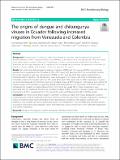Files in this item
The origins of dengue and chikungunya viruses in Ecuador following increased migration from Venezuela and Colombia
Item metadata
| dc.contributor.author | Maljkovic Berry, Irina | |
| dc.contributor.author | Rutvisuttinunt, Wiriya | |
| dc.contributor.author | Sippy, Rachel | |
| dc.contributor.author | Beltran-Ayala, Efrain | |
| dc.contributor.author | Figueroa, Katherine | |
| dc.contributor.author | Ryan, Sadie | |
| dc.contributor.author | Srikanth, Abhinaya | |
| dc.contributor.author | Stewart-Ibarra, Anna M | |
| dc.contributor.author | Endy, Timothy | |
| dc.contributor.author | Jarman, Richard G | |
| dc.date.accessioned | 2022-01-19T17:30:45Z | |
| dc.date.available | 2022-01-19T17:30:45Z | |
| dc.date.issued | 2020-02-19 | |
| dc.identifier | 277524027 | |
| dc.identifier | e65f534e-b250-4e51-a8b9-61f3697db7fc | |
| dc.identifier | 32075576 | |
| dc.identifier | 85079823787 | |
| dc.identifier.citation | Maljkovic Berry , I , Rutvisuttinunt , W , Sippy , R , Beltran-Ayala , E , Figueroa , K , Ryan , S , Srikanth , A , Stewart-Ibarra , A M , Endy , T & Jarman , R G 2020 , ' The origins of dengue and chikungunya viruses in Ecuador following increased migration from Venezuela and Colombia ' , BMC Evolutionary Biology , vol. 20 , 31 . https://doi.org/10.1186/s12862-020-1596-8 | en |
| dc.identifier.issn | 1471-2148 | |
| dc.identifier.other | PubMedCentral: PMC7031975 | |
| dc.identifier.other | ORCID: /0000-0003-3617-2093/work/106838510 | |
| dc.identifier.uri | https://hdl.handle.net/10023/24712 | |
| dc.description | This work was funded by the Armed Forces Health Surveillance Branch (AFHSB) and its Global Emerging Infections Surveillance (GEIS) Section, FY2018 ProMIS ID P0108_18_WR. | en |
| dc.description.abstract | Background: In recent years, Ecuador and other South American countries have experienced an increase in arboviral diseases. A rise in dengue infections was followed by introductions of chikungunya and Zika, two viruses never before seen in many of these areas. Furthermore, the latest socioeconomic and political instability in Venezuela and the mass migration of its population into the neighboring countries has given rise to concerns of infectious disease spillover and escalation of arboviral spread in the region. Results: We performed phylogeographic analyses of dengue (DENV) and chikungunya (CHIKV) virus genomes sampled from a surveillance site in Ecuador in 2014-2015, along with genomes from the surrounding countries. Our results revealed at least two introductions of DENV, in 2011 and late 2013, that initially originated from Venezuela and/or Colombia. The introductions were subsequent to increases in the influx of Venezuelan and Colombian citizens into Ecuador, which in 2013 were 343% and 214% higher than in 2009, respectively. However, we show that Venezuela has historically been an important source of DENV dispersal in this region, even before the massive exodus of its population, suggesting already established paths of viral distribution. Like DENV, CHIKV was introduced into Ecuador at multiple time points in 2013-2014, but unlike DENV, these introductions were associated with the Caribbean. Our findings indicated no direct CHIKV connection between Ecuador, Colombia, and Venezuela as of 2015, suggesting that CHIKV was, at this point, not following the paths of DENV spread. Conclusion: Our results reveal that Ecuador is vulnerable to arbovirus import from many geographic locations, emphasizing the need of continued surveillance and more diversified prevention strategies. Importantly, increase in human movement along established paths of viral dissemination, combined with regional outbreaks and epidemics, may facilitate viral spread and lead to novel virus introductions. Thus, strengthening infectious disease surveillance and control along migration routes and improving access to healthcare for the vulnerable populations is of utmost importance. | |
| dc.format.extent | 12 | |
| dc.format.extent | 4038992 | |
| dc.language.iso | eng | |
| dc.relation.ispartof | BMC Evolutionary Biology | en |
| dc.subject | Chikungunya Fever/epidemiology | en |
| dc.subject | Chikungunya virus/classification | en |
| dc.subject | Colombia/epidemiology | en |
| dc.subject | Dengue/epidemiology | en |
| dc.subject | Dengue Virus/classification | en |
| dc.subject | Disease outbreaks | en |
| dc.subject | Ecuador/epidemiology | en |
| dc.subject | Emigration and Immigration/statistics & numerical data | en |
| dc.subject | Genome, viral | en |
| dc.subject | Genotype | en |
| dc.subject | Humans | en |
| dc.subject | Mutation, missense/physiology | en |
| dc.subject | Phenotype | en |
| dc.subject | Phylogeography | en |
| dc.subject | Sequence analysis, DNA | en |
| dc.subject | South America/epidemiology | en |
| dc.subject | Venezuela/epidemiology | en |
| dc.subject | Zika Virus/isolation & purification | en |
| dc.subject | Zika Virus infection/epidemiology | en |
| dc.subject | RA0421 Public health. Hygiene. Preventive Medicine | en |
| dc.subject | QR Microbiology | en |
| dc.subject | DAS | en |
| dc.subject | SDG 3 - Good Health and Well-being | en |
| dc.subject.lcc | RA0421 | en |
| dc.subject.lcc | QR | en |
| dc.title | The origins of dengue and chikungunya viruses in Ecuador following increased migration from Venezuela and Colombia | en |
| dc.type | Journal article | en |
| dc.contributor.institution | University of St Andrews. Statistics | en |
| dc.identifier.doi | https://doi.org/10.1186/s12862-020-1596-8 | |
| dc.description.status | Peer reviewed | en |
This item appears in the following Collection(s)
Items in the St Andrews Research Repository are protected by copyright, with all rights reserved, unless otherwise indicated.

